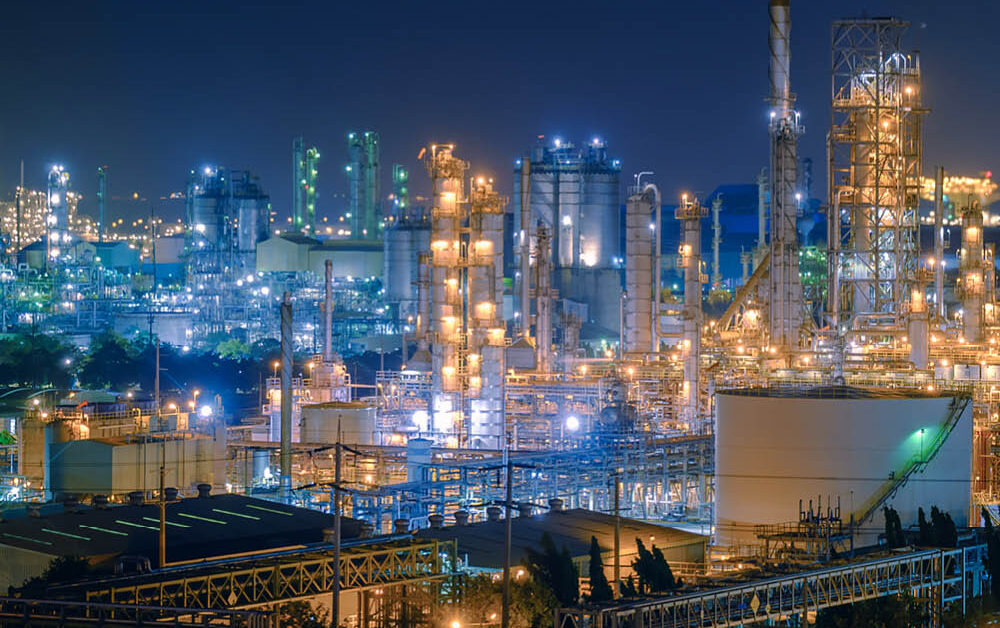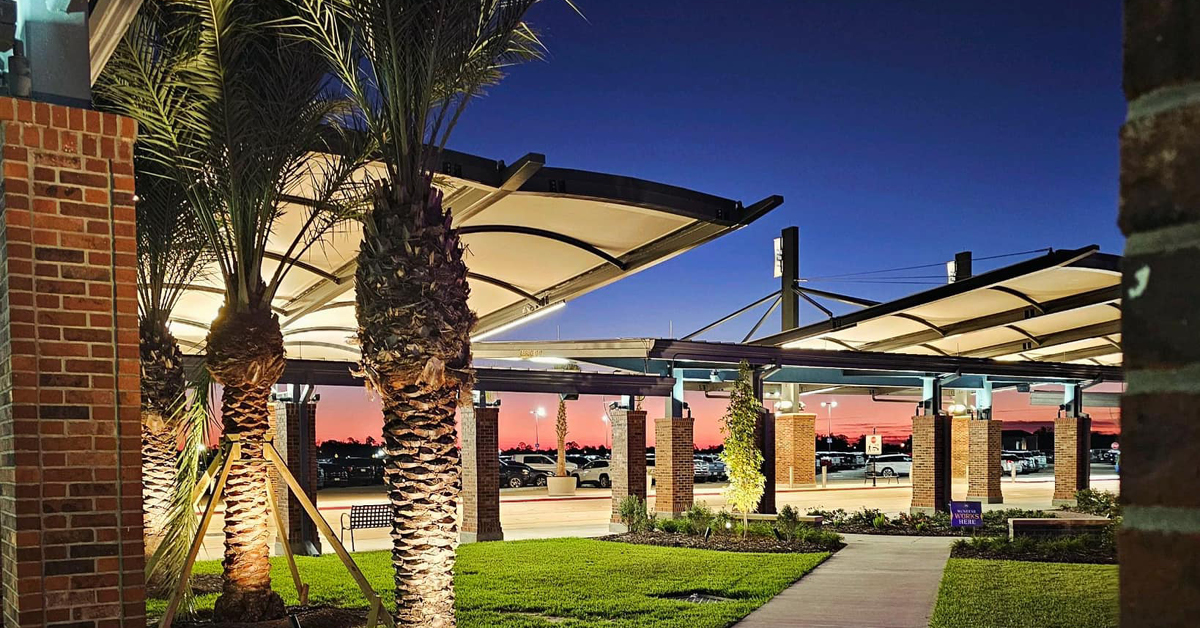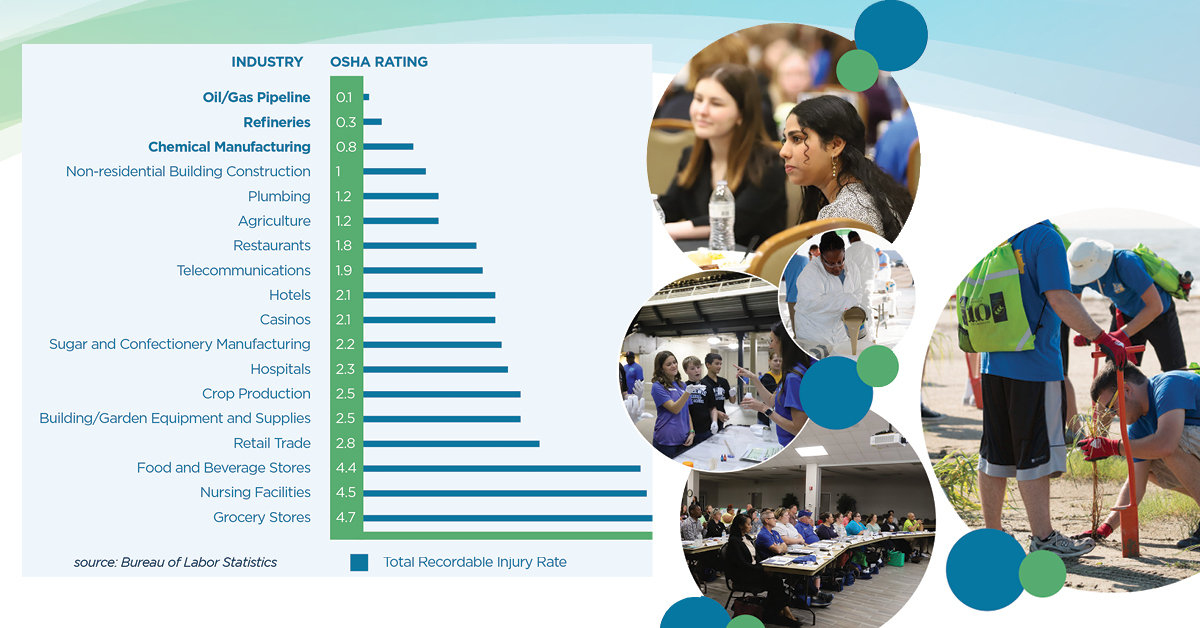
Off Your Game?
August 2021
Lake Area Arts and Culture
August 2021The Impacts of Local Industries are Felt Locally and Worldwide
Local industry is one of the three largest employment sectors in Southwest Louisiana. The benefits of having industries in our area are numerous: the property and sales tax dollars they contribute to our local economy, the jobs – many of which are high paying with good benefits – the charitable contributions, the volunteer hours of their workforce and the economic ripple effect that occurs throughout the region from the money industry and their employees spend locally.
Retail stores, restaurants, housing, healthcare – these sectors benefit. Growth in industry also leads to more options in higher education and skilled worker training programs to provide the needed workforce.
“In February of this year, NASA landed the Mars Rover onto the surface of Mars,” says Jim Rock, executive director of Lake Area Industry Alliance. “Hydrazine was a critical component of that mission. Lonza, one of our local industries, produces 100% of the government’s demand for this ingredient, which is a rocket propellant for satellites.”
“Industries in Southwest Louisiana produce a wide variety of products that our area and the nation requires, such as fuels of every type, and products that go into fabrics, refrigerants, and other automotive components as well as much needed medical supplies,” Rock adds.
The petro-chemical industry is the largest component of manufacturing jobs in Louisiana. It has a multiplier of six, according to the Louisiana Association of Business and Industry. This means that for every job at a local industry, six other jobs are created in a variety of business sectors: office supplies, uniform shops, industrial supplies, restaurants, engineering firms, contractors, courier services, etc.
Throughout the natural disasters experienced in Southwest Louisiana, local industries have been a steady component in the local workforce. They continue to meet the demand for products around the country while remaining a major economic force in our economy, resulting in a steady paycheck for many households here at home.
While we all know these industries are vital to our local economy, unless someone is directly involved with these businesses, they tend to be a bit of a mystery. In this special section, we aim to explain what several different companies make, how the products are made, and how they are used in products that the public uses in their everyday lives.
Westlake Chemical
Claim to Fame:
Westlake Chemical is the largest petrochemical employer in Calcasieu Parish. Over the past 35 years, Westlake has grown to a family of companies with team members now in 11 countries, working together to produce products that are essential to our everyday lives worldwide.
How long has the company been in business?
Westlake Chemical was founded in 1986 by T.T. Chao, with the acquisition of a polyethylene plant in Lake Charles. The company has continued to expand, with much of its growth happening here in Southwest Louisiana. In 2016, Westlake acquired Axiall Corporation, which doubled the company in size. The combined company became the second largest chlor-alkali producer and the second largest PVC producer in the world. The Lake Charles facilities represent Westlake Chemical’s largest concentration of assets and continues as the company’s flagship location.
Number of employees?
There are approximately 2,000 Westlake Chemical employees working in Calcasieu Parish. Globally, Westlake employs approximately 9,200 people working on three continents.
What are the primary products manufactured at this facility?
Westlake’s Lake Charles complex consists of four production sites, plus a marine terminal, and produces ethylene, polyethylene, caustic soda, chlorine, styrene, and other co-products.
How are these chemicals produced?
The Westlake Petrochemical and Polymers facilities’ manufacturing process includes the utilization of natural gas to form ethylene, our building block chemical, which is then used to provide our internal downstream needs in the polyethylene, styrene and vinyls businesses and co-products to the commercial market. The Westlake Petrochemicals Site consists of two ethylene production plants, two polyethylene trains and one styrene monomer production plant. The Westlake Polymers site includes five polyethylene lines.
Westlake Chemical’s Lake Charles North and South sites include two chlor-alkali plants that make caustic soda, chlorine, and PELS; one derivatives plant with five operating units that produce VCM, ethylene-dichloride (EDC), perchloroethylene and trichloroethylene (PER-TRI); a waste treatment unit and four power generation houses.
How are these chemicals utilized in products consumers use routinely?
Whether it’s plastic wrap that keeps our meats and produce fresh, the tires we ride on, the pipes that are essential to ensuring clean drinking water, or the chlorine that helps purifiy drinking water and keeps our pools safe, Westlake plays a vital role in supplying the building blocks for these products and more. Many of our product uses include food packaging and carton liners to dry cleaning bags, toys, and garden tools and thousands of products used by consumers throughout the world.
Sasol Lake Charles Chemical Complex
Claim to Fame:
In 2014, Sasol began construction of a new, seven-facility ethane cracker and derivatives complex adjacent to its existing facility near Westlake. Commissioning was completed in late 2020. The $12.9 billion investment remains one of the largest foreign direct investments in U.S. history
Number of years in business:
The Lake Charles facility has operated since 2001 when Sasol purchased what is now referred to as the Lake Charles Chemical Complex from Condea Vista.
Number of employees:
Globally, Sasol employs more than 30,000 people in more than 30 countries. In North America, Sasol has operations in Arizona, Louisiana, Texas and Pennsylvania. Their Lake Charles Chemical Complex near Westlake, which includes their joint venture with LyondellBasell, supports more than 1,100 employees and contractors.
Primary products manufactured at Sasol and how they are used: The Sasol Lake Charles Chemical Complex manufactures products used in cleaning and personal care markets to manufacture ingredients for soaps, detergents, shampoos and cosmetics. Their specialty chemicals are also used in mild abrasives, thickeners and pharmaceuticals, as well as in the enhanced oil recovery markets.
Short-term and long-term goals: Sasol is committed to advancing chemical and energy solutions that contribute to a thriving planet, society and enterprise. They will continue to focus on manufacturing products safely and reliably while progressing sustainability goals to ensure their business is environmentally, socially and economically sustainable over the long-term. This includes continuously improving their operations and providing value not only to their customers and shareholders but also to the communities where they live and operate.
Cameron Parish Port, Harbor & Terminal District
Claim to Fame:
Globally, the Cameron Parish Port, Harbor & Terminal District exports more liquified natural gas than all but two countries in the world: Qatar and Australia! Cameron Parish is third among nations in the export of LNG. Pretty incredible!
Date established:
The first iteration of a port authority in Cameron Parish was established in 1968. It was then called the West Cameron Port. Later, the East Cameron Port was created. State legislation in 2016 (Act 331) established the Cameron Parish Port, Harbor & Terminal District, which grants the authority under which they currently operate. The current port authority is a merger of the West and East ports.
Number of employees:
Cameron Port staff consists of only two. They function as more of a parish wide economic development organization rather than what most people consider a traditional port, with port owned facilities. They manage project site selection, small business support, traditional chamber of commerce activities, contract procurement support, marketing and promotion of the industries located in Cameron Parish such as Commercial Fisheries, traditional Oil & Gas, LNG export, Alligator Farming, and Oil & Gas Support Services.
Primary products exported:
By far the largest export from Cameron Port District is liquified natural gas. Cheniere Energy’s Sabine Pass facility located in Johnson Bayou exports ~5mtpa (that’s 5 million tons per year) and Cameron LNG located in Hackberry exports roughly 625 TBTU (~2mtpa or 2 million tons per year) which is enough to power 10 large power generation stations for a year.
Major relevance:
EVERY vessel approaching the Port of Lake Charles MUST pass through the Cameron Parish Port District, whether from the Gulf of Mexico through the Calcasieu Ship Channel or the Gulf Intracoastal Waterway (there are 44 miles of the GIWW in Cameron Port District).
Phillips 66 Lake Charles Manufacturing Complex
Claim to fame:
The Phillips 66 Lake Charles Refinery was considered Lake Charles’ oldest war plant and immediately began shipping blending agents to England when the refinery came on stream in 1941. With a new war and the attack on Pearl Harbor, production was brought up to full capacity for the war effort. For 24 hours a day, the refinery produced blending agents for the different grades of aviation gasolines that our armed forces required. When the United States entered the war following the bombing of Pearl Harbor in 1941, the need for wartime supplies focused new attention on petrochemicals – launching a new industry.
Years in business:
This year, Phillips 66 Lake Charles Manufacturing Complex celebrates its 80th anniversary of the refinery. Phillips 66 is proud to be the first petroleum products manufacturer in Calcasieu Parish. (1941-2021)
Number of employees:
750 full time employees; approximately 330 onsite permanent contractors
Primary products manufactured at the facility:
Gasoline, jet fuel, propane, butane, specialty coke, fuels coke, solvents, heating oil, and base oils for use as lubricants.
How are these products produced?
Phillips 66 is an energy manufacturing company. Essentially, we process crude oil into useful products you use every day, like propane and gasoline.
First, we receive crude oil that is either waterborne through the Calcasieu Ship Channel or via pipeline.
Crude oil is a material comprised of different components. These different components have different boiling ranges and the refining process starts by separating crude oil into components based on their boiling ranges. This separation process is called fractionation.
During fractionation, crude oil is heated and a portion of it vaporizes. The vaporized components are the lighter components, including propane (lightest), butane, gasoline range material, jet range material, and diesel (heavier) range material. The remaining components of the crude oil remain in liquid form and include gas oil and residual oil, which are the heaviest components of crude oil. The partially vaporized crude oil is separated in several distillation towers into the different components, so that these components may be further treated to make useable products.
After initial fractionation, we use treatment and conversion processes to remove contaminants and upgrade the quality of the components to make the highest-valued products, depending on the market.
We treat the products to remove impurities and pollutants.
The products are blended to maximize quality, performance, and meet specifications.
And how are they utilized in products consumers use routinely?
Phillips 66 provides energy that improves lives in a safe, environmentally sound, and reliable manner. What we produce enables health, safety, and security for us to live our lives. Refining is the only industry that can produce low-cost, reliable energy for eight billion people in the next several decades.
CITGO Lake Charles Manufacturing Complex
Claim to Fame:
The Maplewood Community in Sulphur was created to support the construction of the Cities Service plant, which is now known as the CITGO Lake Charles Manufacturing Complex. Plans to build a new refinery in the 1940s presented a demand for suitable housing to accommodate a large influx of employees and families to the region. Cities Service entered into an agreement with the Maplewood Housing Corporation to build a one-mile-wide community with 789 homes and apartments. Over time, Maplewood transformed from simply a place to house the workforce into a thriving community complete with a school and infrastructure. Today, Maplewood remains a staple in Southwest Louisiana and spurred generations of families who planted roots here because of Cities Service.
How long has the company been in business?
CITGO roots stretch back more than 110 years, beginning with the founding of Cities Service in 1910. During WWII, there was a dire need for a facility to manufacture and supply the U.S. Armed forces with fuel. Cities Service answered the call, constructing a plant (now the CITGO Lake Charles Manufacturing Complex) in 1944 to refine crude oil into 100-octane fuel for U.S. bombers.
How are the products made?
The refining process is about distillation. It begins with crude oil which, when heated, is split into various components. From there, we further refine these components through different process units and finally blend the refined streams into finished products such as gasoline.
Primary products manufactured at this facility:
The CITGO Lake Charles Manufacturing Complex produces a wide range of products, primarily gasoline, diesel and jet fuels.
How are they utilized in products consumers use routinely?
Consumers use products made at CITGO every day, such as gasoline for your car, jet fuel for the plane that takes you on vacations, and diesel fuel that delivery trucks use on their daily routes. Our petrochemical products are also the building blocks for many household items, especially plastics.
Chennault International Airport
Claim to fame:
Chennault International Airport is an emerging national hub for aerospace and other business such as manufacturing. Its two-mile-long runway and sizeable aircraft parking and operations areas is one of the largest in Louisiana and can handle every aircraft flying in the world today. It’s the landing spot for Air Force One when there’s a presidential visit, the go-to location for government and civilian relief agencies, and home to the Chennault International Airshow.
Years in operation:
Chennault has been an essential economic component for 35 years. It was formed in 1986 — first as an industrial airpark, now an international airport — from land parcels and the infrastructure of an Air Force base that closed in 1963.
How many people work there?
On-site tenant partners such as Northrop Grumman, Citadel Completions, Landlocked Aviation, Million Air and Louisiana Millwork employ some 1,500 people.
What is the primary business at this facility?
Chennault is a complex for aircraft maintenance, renovation and overhaul (MRO) by its major tenant partners. The work is done on military, corporate and private aircraft. Chennault and its tenant partners also facilitate other aviation services and non-aviation business. Chennault is also a working airport — whether the person landing is the president of the United States, a military jet pilot or a general-aviation enthusiast.
Economic footprint: Chennault contributes $300 million to the Southwest Louisiana economy each year.
Planned future projects:
Work has just begun a $4 million facility to build an air cargo warehouse — the first step is entering the air cargo sector. Construction of the 10,000-square-foot warehouse will take approximately 12-months. The project is propelled by $3 million in capital outlay funding from the Louisiana Legislature with the balance of the funding paid by the Chennault International Airport Authority.
Also in the works is the Louisiana Wildlife and Fisheries complex expected to open in summer 2022. The Louisiana National Guard is finalizing its design of the $24 million readiness center. Groundbreaking should take place by year’s end.
Additionally, another company intends to build out its office spaces and potentially build additional general aviation hangars on the former Mallard Cove Golf course, once turned over by the City of Lake Charles.
Cheniere Energy
Claim to Fame:
Cheniere Energy provides clean, secure and affordable energy to the world — energy that can reduce carbon emissions, help lead to cleaner air, and light homes and power factories — all manufactured and transported by modern energy infrastructure run by a world-class workforce in Southwest Louisiana. Their Sabine Pass Liquefaction facility, located in Cameron Parish, was the first ever LNG export facility to open in the lower-48 and is the largest privately financed industrial project in the history of the state of Louisiana, representing a $20 billion investment in energy infrastructure. Within only five years of operations, they are already the largest producer of LNG in the United States and the second largest LNG operator in the world.
Number of years in business:
The Sabine Pass terminal originally opened in 2008 as an LNG import facility. With the changing energy market and access to an immense supply of natural gas in the United States, the facility was converted to an LNG export terminal in 2016.
Number of employees:
In Louisiana, they employ around 450 direct Cheniere employees with an additional 400 contractors on site. During peak construction of their export facility, they had over 5,000 people on site every day.
Primary products manufactured at the facility:
The Sabine Pass facility produces Liquefied Natural Gas or LNG with the help of five fully operational liquefaction units, or “trains.” A sixth train is under construction and expected to be completed in 2022.
How are the products made?
To liquefy natural gas, they cool it to -260°F, causing it to become a liquid and reducing its volume by 600 times. The process basically involves technology similar to your home’s refrigerator or air conditioner, only on a much larger and complex scale. Once the gas is liquefied, they load it onto vessels at their terminal and it is then shipped to customers around the world.
How are they utilized in products consumers use routinely?
Their LNG is primarily used to power homes and businesses around the world. Once their ships reach their final destination, it is estimated that each Cheniere cargo that is used to generate natural gas-fired electricity could potentially result in a reduction of 140,000-200,000 metric tons of CO2 equivalent emissions, if displacing electricity from a coal-fired power plant.
Port of Lake Charles
Claim to Fame:
It’s America’s 11th-busiest port district in tonnage, according to the U.S. Army Corps of Engineers’ latest statistics. It’s the anchor of the Southwest Louisiana economy. It has been a key facilitator for area industries and local agricultural products for nearly a century.
The port district — its full name is the Lake Charles Harbor and Terminal District — fuels, feeds, and builds the world as it drives the Southwest Louisiana economy. It trades with more than 70 countries around the world, moving more than 58 million tons of cargo.
Years in business?
Since 1926. The Port will celebrate its 95th anniversary this fall.
Primary goods and services handled at the Port: The wide variety of cargoes include:
Materials that support petrochemical industries locally and wind-power installations nationally — which, coupled with leased properties for world-class liquefied natural gas (LNG) terminals, are why the Port and the Calcasieu Ship Channel are called “America’s Energy Corridor.”
Rice, lumber and other local “legacy cargoes” that have been handled by the Port for decades. Today, these cargoes flow in both directions. In just the past few months, local rice has been shipped to Africa to help people in need, and the Port recently welcomed the largest international lumber ship ever to visit.
Blades and tower components that are sent to mid-America for assembly at power-generating wind farms.
How are Port-related goods utilized in products consumers use routinely?
The fuel for your vehicle, the raw materials needed by the plant where you work, and even the casinos you visit all have direct ties to the port. The Port doesn’t produce goods and services. It facilitates the needs of companies who make those goods and provide those services. It provides warehouses, docks and railroad services for cargo, as well as land for companies that locate in Southwest Louisiana — all of which boost the local economy. The Port also makes local casino gaming possible by leasing part of its prime waterside acreage to both L’Auberge and Golden Nugget.
Planned projects ahead:
The Port and the Calcasieu Ship Channel are prepared for future growth.
Here are some examples:
Driftwood LNG, a subsidiary of Tellurian Inc., has just signed an agreement to lease port property in West Calcasieu to build a multibillion-dollar LNG terminal.
The Port is exploring opportunities to increase traffic in windmill blades.
An environmentally conscious effort is being launched to better serve vessels needing dockside electrical power while in port.






